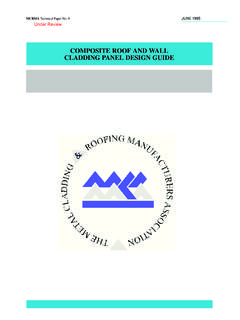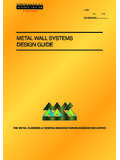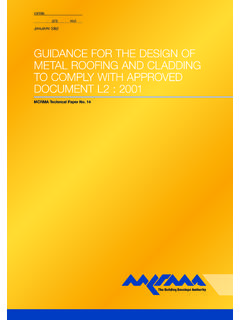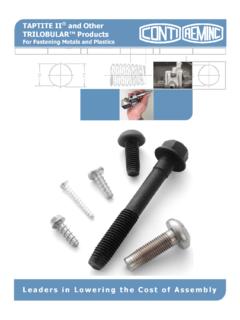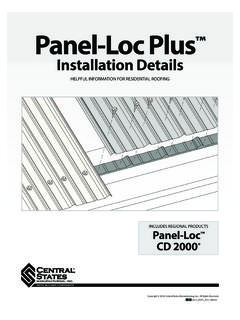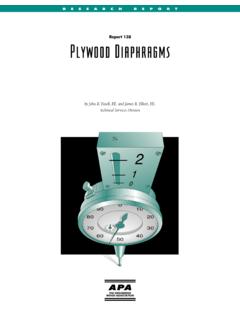Transcription of FA S T E N E R S F O R M E T A L R O O F A N D W A …
1 CI/SfB(47) NhMAY2000 MCRMAT echnical Paper No. 12FA S T E N E R SF O RM E TA LR O O FA N DWA L LC L A D D I N G :DESIGN, DETA I L I N GA N DI N S TA L L AT I O NG U I D ETHE METAL CLADDING & ROOFING MANUFACTURERS ASSOCIAT I O fastener Durability Materials, Weathertightness Aesthetics Headforms, Structural Technical cladding Single Built-up liner panel Composite panel and board Secret fix constructions on structural metal liner tray fastener effective thread fastener Lap Thermal Thermal to 20 The Metal Cladding & Roofing Manufacturers Association Limited.
2 May 2000 All roofing and cladding systems adopting profiled metalas the external surface, usually steel or aluminium, relyupon mechanical fasteners to secure the system to thestructure. The importance of the correct selection ofsuch fasteners is often underestimated by architects,designers, system suppliers and contractors andtherefore this technical paper seeks to give guidance onthe selection of appropriate fasteners designed for usewithin the popular metal roofing and cladding systemsselected by the UK market for modern industrial andcommercial rainscreens, curtain walling and stressed skindesign structures often incorporate fasteners similar tothose within this technical paper.
3 These types of systemshave not been included and therefore advice from eitherthe system supplier or a reputable specialist fastenermanufacturer should be guidance in this document is generally consistentwith that given within BS5427:Part 1:1996, Code ofpractice for the use of profiled roof and wall cladding onbuildings, MCRMA technical guides and relevant NFRC(National Federation of Roofing Contractors) 1494:Part1:1964, Specification for fixing accessoriesfor building purposes. Fixings for sheet, roof, and wallcoverings has not been updated since its publication in1964 and does not reflect the advances that have beenmade within metal cladding systems and fastenertechnology and therefore the Standard has very littlepractical use in today s FixingAsystem of connection between two or FastenerThe mechanical connecting device used for the fixing.
4 Primary fixingAfixing that secures the profiled sheeting or lining to thesupporting structure sheeting to purlin or spacer,spacer to Secondary fixingAfixing that secures the laps of profile sheets to eachother but not to the supporting structure; and also usedto attach lightweight CladdingFor the purposes of this paper, cladding refers to a roofor wall covering comprising of metal profiled cladding may be either an uninsulated sheet or aninsulated system. Insulated cladding systems may beeither factory formed composite panels or Primary fastenersPrimary fasteners are used to transfer all the loads;design, dead, imposed and wind.
5 Acting on the claddingsystem back to the supporting structure and aretherefore relied upon for their structural supporting structure is not solely limited to themain structural steelwork column, beam, rail andpurlin, and would also include the spacer system andthe structural liner/deck, where the primary fasteners are exposed they have toprovide a weathertight seal under all these loadconditions including repetitive dynamic movement of thesheet. Additionally, where primary fasteners areexposed, they are normally required to be coloured tomatch (or even contrast!) the material they are metal cladding systems, primary fasteners areusually threaded and contractors often prefer to use the self-drilling type due to their speed of single operationinstallation.
6 The alternative to self-drillers are selftappers which require a pre-drill operation prior toinstalling the Secondary fastenersUnlike primary fasteners, secondary fasteners are notgenerally relied upon for structural performancehowever, they must be capable of providing a securefixing. In certain applications, for example wheresecondary fasteners are used to provide lateral restraintor where they are part of a stress skin design,secondary fasteners are required to transfer loads andtheir strength would have to be considered in thestructural metal cladding systems, secondary fasteners aretypically used for sheet sidelap stitching and thesecuring of flashings and ancillary components to thesheeting.
7 In order to provide a high degree of clampingto both compress any sealant and to draw the jointtightly together without thread stripping, stitchingfasteners (stitchers) must be purpose-designed. Wheresecondary fasteners are exposed they may also need toprovide a weathertight seal and colour fasteners may often be of the self-drilling orself-tapping threaded type, but rivet type products arealso frequently used. Self-drilling fastenersSelf-drilling fasteners require no pre-drill operation andare therefore often preferred by the self-drill, threadform, and are set as a singlecontinuous operation with a single purpose-designedscrewgun that should have a free running speedbetween 2000 and 2600rpm and be fitted with correctlyset depth locators or torque control fasteners are available with a range of pointconfigurations designed for specific drilling capacitiesand manufacturers advise the minimum recommendedthickness as well as the maximum capacity for eachtype.
8 For example to 3mm. The maximum drillingcapacity of self drilling fasteners is typically the component to be drilled into, usually thestructural purlin/rail/or frame, exceeds the maximum2 Fig 2: Examples of secondary fastenersFig 3: Examples of drillpoints on self drilling fastenersFastener typesFig 1: Examples of primary fastenersSelf tappingSelf drillingSelf drilling forcomposite panelsdrilling capacity of the fastener , then a pre-drill operationwould be necessary prior to installing the fastener (self-tapper, section below).Self-drilling primary fasteners typically have a minimumthread diameter of and secondary fasteners aminimum diameter of The thread pitch may alsovary between fasteners for different substratethicknesses, for example some manufacturers adopt afine (close)
9 Thread configuration for self-drillers into hotrolled steel and a coarser pitch for thinner Self-tapping fastenersSelf-tapping fasteners have no drillpoint and therefore apre-drill operation is contractor/installerrequires two tools and two separate operations to installeach fastener , thus making them significantly slowerthan self-drillers. When using self-tappers it is importantthat the correct pilot-hole size is drilled in order thatoptimum pullout performance is achieved. This requirescareful selection of the drill use of worn drill bits should be avoided. Oversizeholes reduce pullout performance and undersize holesmay prevent the fastener from being installed andsubject the fastener to undue torsional primary fasteners typically have a threaddiameter of There are different thread and lead-in configurations available specific to the fastenermaterial and the material into which the fastener has tothreadform, ie cold or hot rolled steel, timber self-drillers, self-tappers are not limited to 12mmsubstrate thickness.
10 However, installation testing isadvisable above this thickness. As with self-drillers,there are purpose-designed screwguns for self-tappersand the speed should be adjusted to a maximum Other fastener typesSelf-drilling and self-tapping fasteners referred to insections and above are normally of the threadedtype, and, whilst these are the most widely used type,many other types of fastener are available for specificprimary and secondary applications within the metalcladding market. These include:a) Rivet type fastenersThese are most widely used for secondary fixing,typically for connection to thin materials such assidelaps on profiled sheeting and for flashings ( ).
